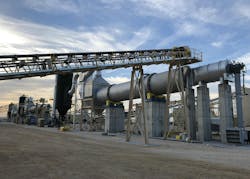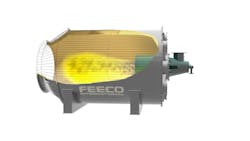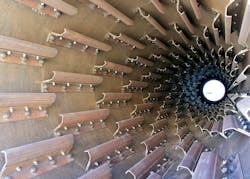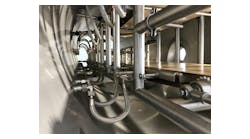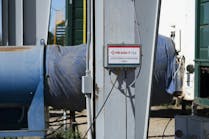Drying heat-sensitive materials with rotary and fluid-bed dryers
Drying heat-sensitive materials presents a unique challenge in industrial processing. The many ways in which materials can be prone to thermal degradation require not only selecting the most suitable drying technology but also customizing the system to optimize for product quality goals. In this article, we’ll explore the two most common types of industrial dryers — rotary and fluid bed — and how they can be optimized to best work with heat-sensitive materials.
Understanding heat-sensitive materials
The term “heat sensitive” can be used to describe a material that experiences a number of challenges associated with heating the material to a higher temperature. Thus, in designing or optimizing a dryer, it becomes necessary to identify specifically how a material is sensitive to heat. The most common challenges associated with drying heat-sensitive materials include:
- Thermal degradation
- Loss of quality or functionality
- Undesirable agglomeration or caking
- Volatile compound loss
- Uneven drying
- Structural damage
- Material buildup
- Change in chemical composition
Some materials, such as potash fertilizers, experience discoloration beyond a certain temperature, while others experience increased attrition. There can be many reasons why a material is deemed sensitive to heat, underscoring the importance of tailoring the dryer’s design to the material’s unique characteristics.
Choosing an appropriate dryer
The choice between rotary and fluid-bed dryers is perhaps the most encountered when evaluating industrial drying systems. Fortunately, the way in which a material responds to heat will help to determine which of these two systems is most appropriate for a given application. For example, fluid-bed dryers are generally considered favorable for materials that require gentle handling, though some attrition is still possible. No matter the dryer type, special consideration must be paid to heat sensitivity to consistently meet product goals.
Rotary dryers and heat-sensitive materials
Rotary dryers (Figure 1) tumble material in a rotating drum, drying material either through contact with combustion gases (direct dryers) or through contact with the externally heated drum shell (indirect dryers). The extensive customization options that rotary dryers offer in primary configuration, add-ons, and modifications make them an ideal choice for a wide range of heat-sensitive materials.
How the material responds to heat significantly influences several system parameters.
Direct versus indirect. Both direct and indirect dryers can be a fit for heat-sensitive materials, depending on the specific material concerns. While direct dryers are favored for their high heat transfer efficiency, indirect dryers offer an essential alternative in some settings, particularly when the material must avoid contact with process gases.
Indirect dryers are often used for materials that would otherwise risk entrainment in process gases or that require an inert or special processing atmosphere. Both direct and indirect configurations can be further customized to suit the unique challenges of the application.
Airflow configuration (Direct dryers only). Direct rotary dryers can be configured for co-current (parallel) or counter-current flow, referring to the direction of airflow in relation to the direction of material flow. Materials that may experience degradation from heat are generally best suited to the co-current airflow configuration, in which the material and the products of combustion flow through the rotating drum in the same direction, from one end to the other.
In a co-current configuration, the products of combustion at their hottest point contact the material in its wettest state, reducing the potential for overheating. In a counter-current configuration, the hottest gases contact the material at its driest point (just before exiting the dryer), when the material is most susceptible to overheating.
Use of a combustion chamber. Also exclusive to direct dryers, the incorporation of a combustion chamber is beneficial for drying materials that might suffer degradation from heat. On a dryer without a combustion chamber, the burner is mounted directly onto the end of the drum. In a co-current dryer, this means that the inlet material could come into direct contact with the flame, which may promote degradation.
When a combustion chamber is used, however, the burner is mounted inside the combustion chamber, containing the combustion and preventing direct contact between the material and the flame (Figure 2). This separation between the material and the combustion helps to avoid overheating and degradation.
Temperature monitoring and control. The ability to carefully monitor and adjust temperature throughout the drum becomes critical when dealing with heat-sensitive materials, as a lack of control can result in wide temperature swings, which affect product quality significantly.
In an indirect dryer, temperature control is more refined, as the drum is externally heated at various points to promote optimal shell temperature along the length of the drum. This allows for precise control over temperature as needed and may require a more advanced monitoring and controls system.
Use and configuration of internals. Various options for internals can also help to accommodate heat-sensitive materials in rotary dryers. Direct dryers utilize lifting flights to create a “curtain” of cascading material across the drum’s cross section, maximizing heat transfer between the material and the products of combustion (Figure 3). Flight design and pattern can be customized in a variety of ways to promote gentle handling and optimized, uniform heat transfer.
Retention time. Retention or residence time also plays an important role in effectively managing heat-sensitive materials. While retention time is the result of several factors, it is largely influenced by drum size, with a longer drum generally encouraging a longer retention time. As such, achieving the optimal retention time requires careful engineering to balance drum diameter, length, rotation speed, and airflow velocity.
Cooling requirements. A heat-sensitive material may require immediate or gradual cooling following drying. Depending on the desired result, this may mean the incorporation of a cooling section at the dryer outlet or the use of a rotary cooler or other industrial cooling system immediately following the dryer.
Fluid-bed dryers and heat-sensitive materials
Unlike a rotary dryer, which is in constant motion, the fluid-bed dryer (Figure 4) is a stationary vessel. The vessel is divided into two parts: the processing zone, which contains the bed of material to be dried, and the plenum, which is toward the bottom and is where initial air distribution occurs. Air passes from the plenum, typically through a perforated plate known as the distributor plate, on which the material bed rests. As air velocity increases and air begins to move through the material bed, the airflow causes particles to become suspended and, eventually, fluidized as the air velocity increases.
While fluid-bed dryers offer far less opportunity for customization compared to rotary dryers, they can be tailored in a couple of key ways to maximize material integrity when dealing with heat-sensitive materials.
Temperature control. Temperature control, particularly at the inlet, is perhaps the most influential factor in drying a heat-sensitive material in a fluid-bed dryer. The ability to control temperature at the inlet allows operators to monitor and adjust temperature as needed. Typically, a lower air temperature is employed for heat-sensitive materials. However, because this can reduce drying efficiency, a lower air temperature must be carefully balanced with the airflow velocity and fluidization regime to ensure maximum heat transfer. Uniform heat distribution through the distributor plate is also essential.
Regime selection. Regime selection can also be an important factor when drying heat-sensitive materials in fluid-bed dryers. The regime refers to the material flow pattern within the vessel and is a direct result of the airflow velocity. Choosing the right fluidization regime ensures even heating while minimizing material degradation and attrition, which are common challenges in heat-sensitive drying.
A number of regimes are possible, ranging from slow and gentle to fast and chaotic, with each one becoming less dense (or more “dilute”) as air velocity increases (Figure 5). Depending on how the material responds to heat, some regimes may be more suitable than others.
Regime selection requires finding the appropriate equilibrium between heat transfer and particle movement. The bed must be dilute enough to avoid uneven heating (and therefore potential localized overheating) of material. Some solids mixing is ideal. However, as degradation is often a concern, too much particle movement may encourage attrition as particles collide.
At the same time, a short retention time, encouraged by a higher airflow velocity (and therefore more turbulent regime) can help to prevent overheating. But retention time must be sufficient to achieve the necessary heat transfer and drying. More turbulent regimes are also associated with a higher carryover when fines are present.
Since a fluid bed will typically use very cool drying gases (compared to other plug flow designs such as rotary), the exhaust gas is commonly recycled back into the drying gas to reduce fuel consumption and increase efficiency. Fluid-bed dryers can be configured to operate in zones with varying gas temperatures.
Testing to ensure success
Designing or optimizing a rotary or fluid-bed crying system for a heat-sensitive material often relies on test work such as that carried out in the FEECO Innovation Center. Testing provides a systematic approach to determining a material’s response to the drying process, allowing producers to identify the most suitable dryer type, as well as establish key process criteria.
In addition to establishing the basic drying process requirements, testing can also be used to refine process and material parameters to achieve the best result. Depending on the dryer type, this might include optimizing:
- Flight design and pattern
- Drum sizing
- Drum rotational speed and slope
- Airflow velocity
- Fluidization regime
- Retention time
- Material pretreatment requirements
- Temperature profiles
- Feed and product rates
- System pressures
Navigating equipment selection and design
Drying heat-sensitive materials requires a deep understanding of material behavior, meticulous process design, and careful equipment selection. Rotary dryers and fluid-bed dryers each offer unique advantages for handling such materials, with the choice between these systems relying on the specific challenges associated with the material.
The importance of testing in designing or optimizing a system for a heat-sensitive material cannot be overstated. Such test work provides invaluable data to guide decision-making, ensuring that the drying system is tailored to achieve both process efficiency and product quality. However, navigating these complexities requires more than just equipment — it demands expertise. Partnering with an experienced provider ensures access to the technical knowledge, process insight, and testing capabilities necessary to overcome the challenges of drying heat-sensitive materials and achieve optimal results with confidence, no matter what dryer type is selected.
FEECO International
